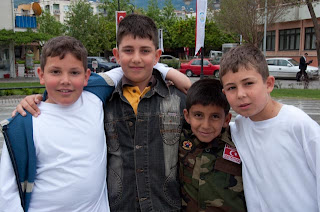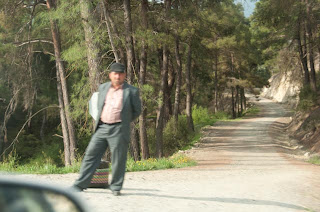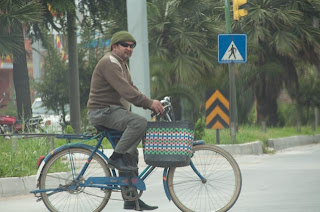
Hieropolis is yet another ancient city, this time in the upper Menderes Valley (that's where the word "meander" comes from...). This is geothermal country and the guidebooks say that there are at least seventeen thermal springs in the area, so it makes sense that ancient people would build their cities near these places with healing benefits.
There are two entrances to Hieropolis and the guidebooks aren't very specific about which entrance is advised, so we went to the north entrance, paid our ticket fee and started walking. We also had no idea how far we would have to walk or what kind of terrain, so it came as a surprise to find that the first kilometer of rough dirt road, or the parallel 'paved' Roman road (believe me, dirt roads are far better) was lined on both sides with crypts and sarcophagi. There were hundreds, maybe thousands, and they were sometimes stacked two or three high.

Many are beautifully carved and most have some sort of inscription. Some, like this one, seem to have the occupant's life story written on the front. I like the inscriptions a lot. The various items have been partially or completely exposed to the elements for centuries and are in various states of decay. Most if not all are carved from limestone and the most weathered, like the one above, are ridged and pitted by the centuries of exposure. Lichen has grown all over the exposed surfaces, and the areas that have been excavated have a clean buff color.
It is very interesting to see the different burial styles that were used through the ages. There are the peaked-roof coffin-style boxes like the first image, crypts that are like little houses, rounded-roof buildings like a half-cylinder laying on its side (these almost seem like bread ovens). The other thing that is interesting to note is the different styles of ornamentation. Most are clearly Roman in origin, having ornaments and lettering that we are familiar with from their pagan pre-Christian origins. Then we see some crypts marked with crosses.
I knew, coming to Turkey, that for millenia this has been a cultural and religious crossroads. Islam may be the predominant religion of the citizens of Turkey now, but it is the most recent of the major religions to arrive. It seems that the Mother Goddess (Cybele) was worshipped here for thousands of years before any of the major civilizations arrived. The Hittites, Greeks and Romans brought their pagan gods, the Byzantines brought Christianity, and Jews were always in neighboring lands and came here in droves when they were diven out of Spain in the middle ages. Muslims did not arrive until 900AD or later.

With so many different religions represented in this area, it's not surprising that there is such a mish-mash of cultures, languages and even alphabets found in these necropoli... Greek, Latin, Hebrew, Arabic. Above is an ornament from a sarcophagus in the Hieropolis museum depicting a Roman and a Seljuk, Turk or Arab. They appear to be friends, equals, brothers, companions, and possibly both buried together.

There is also plenty of pagan imagery, from flowers, leaves, garlands, and graphical patterns to a unique 'green man' I found on this particular Corinthian capital. Most of these elaborate carvings at the tops of the columns depict leaves and animals.
Once I had made my way through and beyond these hundreds of burials, I came to the city ruin. There was a theater, a public bath and latrine, a basilica and a variety of other buildings. Finally, after a walk of two kilometers I found out why Hieropolis had been built on this site: Pamukkale!

Pamukkale is a hillside of limestone where the thermal groundwater has leached all kinds of minerals and calcium through the stone and created white terraced pools that cascade down the hillside. You can see this natural geographic formation from many miles away. For many years, millenia in fact, people have bathed in these shallow cascading pools. Recently, they have suffered from over-use and are mostly protected from over-eager bathers. The town of Pamukkale (a tourist town) is below the terraces, and Hieropolis and its museum are on the top level, stretching north.

From the top of the terraces, you can look off into the Meander (Menderes) Valley as if you were in an infinity pool! The water just seems to drop off into space. The color of the water is different depending upon what the predominant mineral is in that particular pool, but mostly the water has a milky quality to it.

Also at the top of the Pamukkale pools is a thermal pool littered with pieces of ancient buildings. There have been many earthquakes in this area, and much of the ruin is due to these events. In this pool, visitors can bathe in warm water among the scattered pieces.

After a long visit to Hieropolis and Pamukkale, we headed through the mountains for the next ancient ruin: Aphrodisias. Since this is in a rather remote valley, we had to drive through the mountains and then down into a new valley. The further south we go, the more the landscape changes. This afternoon, we got out of the car to take a few pictures and were hit with a new fragrance. This time it was orange blossoms. It smelled like jasmine! So now we have olive trees, oranges, lilacs, wisteria, lavender and others that I can't remember right now. It's just beautiful!

The final photo treat is of a simple farmhouse on the road today. Most houses are unadorned and rather ramshackle. This one had a design that I had not previously seen on a house, but looks a lot like a design that is seen all over the country in the form of glass beads, stickers, painings on vehicles, etc. That is a pattern of rough concentric ovals in blue, black and white that resemble an eyeball. Here it is referred to as the "evil eye" or "nazar boncugu" and is a good-luck charm to keep the evil away. This house is made of stone, plastered over, and then each stone has been outlined with scratches in the plaster to look like eyeballs. Most of the houses I have seen have the red or orange roof tiles and blue or green doors and window sashes. It is a beautiful combination!
 Today is my last day in Turkey. I'm looking forward to coming home, but I'm going to miss all of the wonderful experiences this amazing country has to offer. I came for the cultural experience, but there is so much history here too. Different religions, people from all over the world... kind of like the US.
Today is my last day in Turkey. I'm looking forward to coming home, but I'm going to miss all of the wonderful experiences this amazing country has to offer. I came for the cultural experience, but there is so much history here too. Different religions, people from all over the world... kind of like the US. Parking the car, we noticed an unusual number of kids and families on the streets. Then we saw the main square had wreaths all around the Ataturk statue. Some kids walked by, and we greeted them. They seemed to speak a bit of English, so we asked them if it was a holiday. They said yes, it was National Sovereignity Day and Childrens' Day, also!
Parking the car, we noticed an unusual number of kids and families on the streets. Then we saw the main square had wreaths all around the Ataturk statue. Some kids walked by, and we greeted them. They seemed to speak a bit of English, so we asked them if it was a holiday. They said yes, it was National Sovereignity Day and Childrens' Day, also! After getting their photos and saying goodbye, Robert went to make his purchase and I went to a couple of other stores to say my goodbyes. The fellow above and his brother were very friendly a couple of nights ago and offered to be "my brothers" if I needed to buy or negotiate a carpet purchase from one of the other merchants. One of them is a guitar player and they both want to connect on Facebook.
After getting their photos and saying goodbye, Robert went to make his purchase and I went to a couple of other stores to say my goodbyes. The fellow above and his brother were very friendly a couple of nights ago and offered to be "my brothers" if I needed to buy or negotiate a carpet purchase from one of the other merchants. One of them is a guitar player and they both want to connect on Facebook. Above is some ancient Roman mosaic tile work from Ephesus. This one was on the road in front of a residence. I think it is a sign of welcome to all visitors to this home. Just like our experience with the Turkish people on this trip!
Above is some ancient Roman mosaic tile work from Ephesus. This one was on the road in front of a residence. I think it is a sign of welcome to all visitors to this home. Just like our experience with the Turkish people on this trip! My final impression of Turkey is that, of all the places I have ever visited, the Turkish people are by far the most friendly, generous and helpful in the world. I would visit Turkey again in an instant. The photo above is of our hosts at the Ephesia Hotel: (from left) Mehmet, the food and beverage manager, Reza, the hotel owner, and Omer, our restaurant waiter. I hope to see them and Turkey again soon!
My final impression of Turkey is that, of all the places I have ever visited, the Turkish people are by far the most friendly, generous and helpful in the world. I would visit Turkey again in an instant. The photo above is of our hosts at the Ephesia Hotel: (from left) Mehmet, the food and beverage manager, Reza, the hotel owner, and Omer, our restaurant waiter. I hope to see them and Turkey again soon!



















































